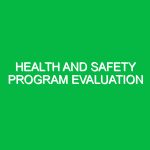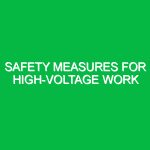Mining operations are critical to global economies, providing essential resources such as coal, minerals, and metals. However, the pursuit of these resources often comes with significant risks to workers’ health and safety. Safety in mining operations is not just a regulatory requirement; it is a moral imperative that protects lives, ensures sustainable practices, and maintains the integrity of the environment. In this article, we will delve into the various hazards associated with mining, explore best practices for safety, and discuss the regulations that govern this essential industry.
Understanding Safety in Mining Operations
Safety in mining operations encompasses the procedures, policies, and practices aimed at preventing accidents, injuries, and environmental damage during mining activities. The relevance of safety in the Health, Safety, and Environment (HSE) domain cannot be overstated. Every year, thousands of mining accidents occur worldwide, resulting in severe injuries and fatalities. According to the U.S. Mine Safety and Health Administration (MSHA), in 2020 alone, there were 29 fatalities in mining operations in the United States. These statistics highlight the pressing need for stringent safety measures and continuous improvement in mining practices.
Potential Hazards and Risks in Mining Operations
Mining operations present a myriad of hazards, which can be broadly categorized into the following groups:
1. Physical Hazards
Physical hazards in mining include slips, trips, falls, and equipment-related injuries. The terrain in mining sites can be rough and unstable, leading to accidents. Heavy machinery, such as excavators and haul trucks, pose significant risks if not operated correctly. For instance, a report from the National Institute for Occupational Safety and Health (NIOSH) highlighted an incident where an operator was crushed by a falling rock due to inadequate ground support. Such incidents underline the importance of proper training and adherence to safety protocols.
2. Chemical Hazards
Mining operations often involve exposure to hazardous chemicals, including dust, solvents, and heavy metals. Silica dust, in particular, is a notorious risk in many mining operations, leading to respiratory issues such as silicosis. The World Health Organization (WHO) has classified crystalline silica as a Group 1 carcinogen. Implementing dust control measures and providing personal protective equipment (PPE) can significantly reduce these risks.
3. Biological Hazards
Workers in mining operations may also be exposed to biological hazards, such as bacteria and viruses from contaminated water sources or insects. For instance, malaria and dengue fever are prevalent in some mining regions. Proper sanitation, pest control measures, and vaccination programs can help mitigate these risks.
4. Ergonomic Hazards
Mining often involves repetitive motions and manual handling of heavy materials, leading to musculoskeletal disorders. A study conducted by the Centre for Disease Control and Prevention (CDC) indicated that ergonomic injuries accounted for a significant percentage of mining-related injuries. Implementing ergonomic assessments and promoting proper lifting techniques can alleviate these concerns.
5. Environmental Hazards
Mining operations can lead to environmental degradation, including soil erosion, water contamination, and habitat destruction. The use of toxic chemicals in mineral extraction can have long-lasting effects on local ecosystems. Implementing sustainable mining practices and adhering to environmental regulations is essential for minimizing these impacts.
Best Practices and Safety Precautions
To mitigate the risks associated with mining operations, several best practices should be adopted:
1. Comprehensive Training Programs
Training is a cornerstone of safety in mining. New employees should undergo extensive training on safety protocols, equipment operation, and hazard recognition. Regular refresher courses ensure that all workers remain aware of the latest safety practices. Personal anecdotes from seasoned miners often emphasize the role of training in preventing accidents. For instance, one miner recounted how a simple training session on proper lifting techniques saved him from a serious back injury.
2. Regular Safety Audits
Conducting regular safety audits can help identify potential hazards before they lead to accidents. These audits should assess equipment maintenance, worker adherence to safety protocols, and the effectiveness of safety equipment. Companies like Rio Tinto have implemented comprehensive safety audits that have significantly reduced incidents by ensuring compliance with safety standards.
3. Personal Protective Equipment (PPE)
The use of appropriate PPE is crucial in protecting workers from various hazards. This includes helmets, gloves, respiratory protection, and hearing protection. Employers must ensure that workers are trained in the correct use and maintenance of PPE. A study published in the Journal of Occupational and Environmental Hygiene found that proper use of PPE reduced injury rates by 30% in mining operations.
4. Emergency Preparedness
Mining operations must have robust emergency preparedness plans in place. This includes regular drills, clear communication protocols, and accessible emergency equipment. An incident in a gold mine in South Africa serves as a reminder of the importance of preparedness. When a fire broke out, the well-rehearsed emergency response plan enabled workers to evacuate swiftly, preventing injuries and fatalities.
5. Mental Health Support
Mental health is an often-overlooked aspect of safety in mining operations. The isolation and stress associated with mining work can lead to mental health issues. Implementing support programs, providing access to counseling, and fostering a culture of openness regarding mental health can enhance overall workplace safety and employee well-being.
Regulations and Standards Governing Safety in Mining Operations
Several regulations and standards govern safety practices in mining operations to protect workers and the environment:
1. The Mine Safety and Health Act (MSHA)
In the United States, the Mine Safety and Health Administration (MSHA) enforces regulations to protect miners. The Mine Safety and Health Act mandates safe working conditions, regular inspections, and reporting of accidents. Compliance with MSHA standards is essential for all mining operations.
2. The Occupational Safety and Health Administration (OSHA)
OSHA sets and enforces protective workplace safety and health standards. Mining companies must comply with OSHA regulations, particularly concerning worker safety training, equipment safety, and hazard communication.
3. International Standards
Globally, organizations such as the International Organization for Standardization (ISO) provide frameworks for safety management systems. ISO 45001 is a widely recognized standard for occupational health and safety, guiding organizations in reducing workplace risks and improving safety performance.
Conclusion
Safety in mining operations is a multifaceted issue that requires a commitment from all stakeholders, including employers, employees, and regulators. By understanding the potential hazards, implementing best practices, and adhering to regulations, the mining industry can significantly reduce risks and protect the health and safety of its workforce. As someone who has witnessed the impact of effective safety measures firsthand, I can attest to their importance. In the end, prioritizing safety not only saves lives but also fosters a culture of responsibility and care that benefits everyone involved in the mining sector.


